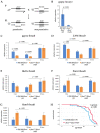Retrotransposons Down- and Up-Regulation in Aging Somatic Tissues
- PMID: 35011640
- PMCID: PMC8750722
- DOI: 10.3390/cells11010079
Retrotransposons Down- and Up-Regulation in Aging Somatic Tissues
Abstract
The transposon theory of aging hypothesizes the activation of transposable elements (TEs) in somatic tissues with age, leading to a shortening of the lifespan. It is thought that TE activation in aging produces an increase in DNA double-strand breaks, contributing to genome instability and promoting the activation of inflammatory responses. To investigate how TE regulation changes in somatic tissues during aging, we analyzed the expression of some TEs, as well as a source of small RNAs that specifically silence the analyzed TEs; the Drosophila cluster named flamenco. We found significant variations in the expression levels of all the analyzed TEs during aging, with a trend toward reduction in middle-aged adults and reactivation in older individuals that suggests dynamic regulation during the lifespan.
Keywords: Idefix; ZAM; gypsy; longevity; transposons.
Conflict of interest statement
The authors declare no conflict of interest.
Figures



Similar articles
-
Chromatin-modifying genetic interventions suppress age-associated transposable element activation and extend life span in Drosophila.Proc Natl Acad Sci U S A. 2016 Oct 4;113(40):11277-11282. doi: 10.1073/pnas.1604621113. Epub 2016 Sep 12. Proc Natl Acad Sci U S A. 2016. PMID: 27621458 Free PMC article.
-
Age-associated de-repression of retrotransposons in the Drosophila fat body, its potential cause and consequence.Aging Cell. 2016 Jun;15(3):542-52. doi: 10.1111/acel.12465. Epub 2016 Apr 12. Aging Cell. 2016. PMID: 27072046 Free PMC article.
-
Production of Small Noncoding RNAs from the flamenco Locus Is Regulated by the gypsy Retrotransposon of Drosophila melanogaster.Genetics. 2016 Oct;204(2):631-644. doi: 10.1534/genetics.116.187922. Epub 2016 Aug 24. Genetics. 2016. PMID: 27558137 Free PMC article.
-
Impact of multiple insertions of two retroelements, ZAM and Idefix at an euchromatic locus.Genetica. 2000;109(1-2):53-9. doi: 10.1023/a:1026534207401. Genetica. 2000. PMID: 11293795 Review.
-
History of the discovery of a master locus producing piRNAs: the flamenco/COM locus in Drosophila melanogaster.Front Genet. 2014 Aug 4;5:257. doi: 10.3389/fgene.2014.00257. eCollection 2014. Front Genet. 2014. PMID: 25136352 Free PMC article. Review.
Cited by
-
Generation of somatic de novo structural variation as a hallmark of cellular senescence in human lung fibroblasts.Front Cell Dev Biol. 2023 Dec 13;11:1274807. doi: 10.3389/fcell.2023.1274807. eCollection 2023. Front Cell Dev Biol. 2023. PMID: 38152346 Free PMC article.
-
Exploring the Relationship of Transposable Elements and Ageing: Causes and Consequences.Genome Biol Evol. 2025 May 30;17(6):evaf088. doi: 10.1093/gbe/evaf088. Genome Biol Evol. 2025. PMID: 40373205 Free PMC article. Review.
-
Artificially stimulating retrotransposon activity increases mortality and accelerates a subset of aging phenotypes in Drosophila.Elife. 2022 Aug 18;11:e80169. doi: 10.7554/eLife.80169. Elife. 2022. PMID: 35980024 Free PMC article.
-
Exploring the Role of Clustered Mutations in Carcinogenesis and Their Potential Clinical Implications in Cancer.Int J Mol Sci. 2024 Jun 19;25(12):6744. doi: 10.3390/ijms25126744. Int J Mol Sci. 2024. PMID: 38928450 Free PMC article. Review.
-
Transposable Elements: Major Players in Shaping Genomic and Evolutionary Patterns.Cells. 2022 Mar 19;11(6):1048. doi: 10.3390/cells11061048. Cells. 2022. PMID: 35326499 Free PMC article. Review.
References
-
- Pélisson A., Song S.U., Prud’homme N., Smith P.A., Bucheton A., Corces V.G. Gypsy transposition correlates with the production of a retroviral envelope-like protein under the tissue-specific control of the Drosophila flamenco gene. Embo J. 1994;13:4401–4411. doi: 10.1002/j.1460-2075.1994.tb06760.x. - DOI - PMC - PubMed
Publication types
MeSH terms
Substances
Grants and funding
LinkOut - more resources
Full Text Sources
Medical
Molecular Biology Databases

